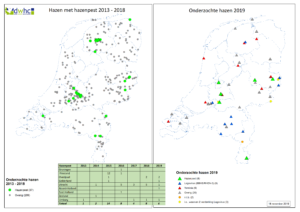

In October and the first weeks of November 2019, ten hares were submitted to DWHC for post-mortem examination. In three hares tularaemia (rabbit fever) has been diagnosed.
These three hares were found dead in three different provinces: province of North Holland, province of Overijssel and province of Limburg. In the province of North Holland it was the first case of tularaemia being confirmed. The hare was found in the municipality of Gooise Meren.
Rabbit fever had been diagnosed in the provinces of Overijssel and Limburg before, but now the disease has been found in other parts of these provinces. In the province of Overijssel the hare was found dead in the municipality of Raalte and in the province of Limburg the hare was found dead in the municipality of Heerlen. Up to now 49 hares have been post-mortem examined at DWHC in 2019, six of which have been diagnosed with tularaemia (see map below, in Dutch: hazenpest = tularaemia; hazen = hares; overig = the rest).

Yersiniosis, also referred to as pseudotuberculosis and rodent disease, is caused by the bacterium Yersinia pseudotuberculosis. The Yersinia bacterium is widespread in nature. It is a so-called zoonosis: a person can get infected through contact with an infected animal.
The lagoviruses found in hares are European Brown Hare Syndrom (EBHS) and Rabbit Haemorrhagic Disease Virus-2 (RHDV-2). EBHS was first diagnosed in hares in the 90s in the Netherlands. In 2015, RHDV-2 was diagnosed for the first time in a hare in the Netherlands.